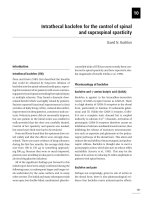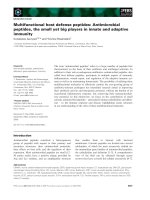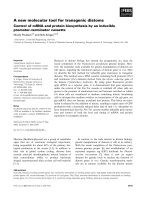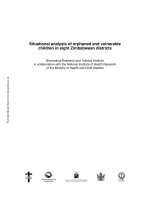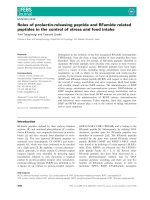Control of Innate and Adaptive Immune Responses during Infectious Diseases ppt
Bạn đang xem bản rút gọn của tài liệu. Xem và tải ngay bản đầy đủ của tài liệu tại đây (2.5 MB, 189 trang )
Control of Innate and Adaptive Immune
Responses during Infectious Diseases
Julio Aliberti
Editor
Control of Innate and
Adaptive Immune Responses
during Infectious Diseases
Editor
Julio Aliberti
Associate Professor
Divisions of Molecular Immunology and Pulmonary Medicine
Cincinnati Children’s Hospital Medical Center and School of Medicine
University of Cincinnati
Cincinnati, OH, USA
ISBN 978-1-4614-0483-5 e-ISBN 978-1-4614-0484-2
DOI 10.1007/978-1-4614-0484-2
Springer New York Dordrecht Heidelberg London
Library of Congress Control Number: 2011936972
© Springer Science+Business Media, LLC 2012
All rights reserved. This work may not be translated or copied in whole or in part without the written
permission of the publisher (Springer Science+Business Media, LLC, 233 Spring Street, New York,
NY 10013, USA), except for brief excerpts in connection with reviews or scholarly analysis. Use in
connection with any form of information storage and retrieval, electronic adaptation, computer software,
or by similar or dissimilar methodology now known or hereafter developed is forbidden.
The use in this publication of trade names, trademarks, service marks, and similar terms, even if they
are not identified as such, is not to be taken as an expression of opinion as to whether or not they are
subject to proprietary rights.
Printed on acid-free paper
Springer is part of Springer Science+Business Media (www.springer.com)
v
Upon infection, pathogen and host perform a complex interaction that ultimately
aims to achieve elimination of the invading microbe with the least amount of dam-
age to host tissues and organs. Interestingly, both sides of this equation co-evolved
several mechanisms that mediate pathogen recognition, initiation and expansion of
immune responses, neutralization of toxic elements and elimination of replicating
organisms and finally healing and remodeling of damaged tissues. On one side
pathogens evolved mechanisms to evade recognition and killing, while on the other
side, host express numerous (sometimes redundant) mechanisms of recognition and
elimination of the pathogen. Nonetheless, it is clear that an absolute successful
strategy on the pathogen side would be lethal to both host and pathogen. Therefore,
several evasion mechanisms are seen among several microbes. The most successful
ones are not necessarily the most abundantly found within the host, but those that
can achieve transmission. On the other hand, hosts need a robust and extended
immune response in order to expand memory cells. This critical balance is where
the co-evolution between host and pathogens lies. This book covers several aspects
of induction, control and evasion of host immune response during infectious dis-
eases. Multiple aspects are covered and each chapter focuses on one prominent
infectious agent.
Cincinnati, OH Julio Aliberti
Preface
vii
1 Resolution of Inflammation During Toxoplasma gondii Infection 1
Julio Aliberti
2 Mechanisms of Host Protection and Pathogen
Evasion of Immune Response During Tuberculosis 23
Andre Bafica and Julio Aliberti
3 NKT Cell Activation During (Microbial) Infection 39
Jochen Mattner
4 Regulation of Innate Immunity
During Trypanosoma cruzi Infection 69
Fredy Roberto Salazar Gutierrez
5 B Cell-Mediated Regulation of Immunity
During Leishmania Infection 85
Katherine N. Gibson-Corley, Christine A. Petersen,
and Douglas E. Jones
6 Control of the Host Response to Histoplasma Capsulatum 99
George S. Deepe, Jr.
7 Modulation of T-Cell Mediated Immunity by Cytomegalovirus 121
Chris A. Benedict, Ramon Arens, Andrea Loewendorf,
and Edith M. Janssen
8 T Cell Responses During Human Immunodeficiency
Virus (HIV)-1 Infection 141
Claire A. Chougnet and Barbara L. Shacklett
Index 171
Contents
ix
Julio Aliberti, Ph.D. Associate Professor, Divisions of Molecular Immunology
and Pulmonary Medicine, Cincinnati Children’s Hospital Medical Center
and School of Medicine, University of Cincinnati, Cincinnati, OH, USA
Ramon Arens Division of Developmental Immunology, La Jolla Institute
for Allergy and Immunology, La Jolla, CA, USA
Andre Bafica, M.D., Ph.D. Assistant Professor, Department of Microbiology,
Immunology and Parasitology, Federal University of Santa Catarina,
Florianopolis, SC, Brazil
andre.bafi
Chris A. Benedict Division of Immune Regulation, La Jolla Institute
for Allergy and Immunology, La Jolla, CA, USA
Claire A. Chougnet Division of Molecular Immunology, Cincinnati Children’s
Hospital Research Foundation and Department of Pediatrics, University of
Cincinnati, Cincinnati, OH, USA
George S. Deepe. Jr, M.D. Professor, Veterans Affairs Hospital, Cincinnati, OH,
USA; Division of Infectious Diseases, University of Cincinnati College of Medicine,
Cincinnati, OH, USA
Katherine N. Gibson-Corley Department of Veterinary Pathology,
College of Veterinary Medicine, Iowa State University, Ames, IA, USA
Fredy Roberto Salazar Gutierrez, M.D., Ph.D. Assistant Professor,
School of Medicine, Antonio Nariño University, Bogotá, Colombia
Contributors
x Contributors
Edith M. Janssen Division of Molecular Immunology, Cincinnati Children’s
Hospital Research Foundation, University of Cincinnati College of Medicine,
Cincinnati, OH, USA
Douglas E. Jones Department of Veterinary Pathology, College of Veterinary
Medicine, Iowa State University, Ames, IA, USA
Andrea Loewendorf Division of Molecular Immunology, La Jolla Institute
for Allergy and Immunology, La Jolla, CA, USA
Jochen Mattner, M.D. Professor of Molecular Microbiology and Infection
Immunology, University Hospital of Erlangen, Microbiology Institute –
Clinical Microbiology, Immunology and Hygiene, Erlangen, Germany
Christine A. Petersen Department of Veterinary Pathology,
College of Veterinary Medicine, Iowa State University, Ames, IA, USA
Barbara L. Shacklett Department of Medical Microbiology and Immunology,
School of Medicine, University of California, Davis, CA, USA
1
J. Aliberti (ed.), Control of Innate and Adaptive Immune Responses
during Infectious Diseases, DOI 10.1007/978-1-4614-0484-2_1,
© Springer Science+Business Media, LLC 2012
Abstract Upon Toxoplasma gondii host infection, a powerful immune response
takes place in order to contain dissemination of the parasite and prevent mortality.
Once parasite proliferation is contained by IFN-J-dependent responses, nevertheless ,
parasite immune escape prevents complete clearance characterizing the onset of the
chronic phase of infection, with a continuous (and powerful) cell-mediated immu-
nity. Such potent responses are kept under tight control by several, non-redundant
mechanisms that control pro-inflammatory mediators. Including cytokines, such as
members of the IL-10 family, TGF-beta, the membrane receptors, ICOS, CTLA4
and a class of anti-inflammatory eicosanoids, the lipoxins. In this chapter we address
the host strategies that keep pro-inflammatory responses under control during chronic
disease. On the other hand, we approach the perspective of the pathogen, which
pirates the host’s machinery to its own advantage as a part of the pathogen’s immune-
escape mechanisms.
1.1 Introduction
Toxoplasmosis is caused by the protozoan parasite, Toxoplasma gondii. The pathogen
can be found worldwide and is particularly prevalent in the United States, where it
is estimated that more than 60 million people may be infected. Among those who
are infected, few develop symptoms due to healthy immune system that usually
prevents the parasite from causing illness. Nevertheless, within the high risk group
are pregnant women and individuals with compromised immune systems.
J. Aliberti (*)
Divisions of Molecular Immunology and Pulmonary Medicine,
Cincinnati Children’s Hospital Medical Center and School of Medicine,
University of Cincinnati, Cincinnati, OH, USA
e-mail:
Chapter 1
Resolution of Inflammation
During Toxoplasma gondii Infection
Julio Aliberti
2
J. Aliberti
Felines, including the house cat are definitive hosts in which it is observed the
sexual stages of T. gondii and thus, are considered to be the main parasite reservoirs.
Cats become infected with T. gondii by carnivorism (Fig. 1.1). After tissue cysts or
oocysts are ingested, viable organisms are released and invade epithelial cells of the
small intestine, where they undergo an asexual cycle followed by a sexual cycle and
then form oocysts, which can be excreted. The unsporulated oocyst takes 1–5 days
after excretion to sporulate (become infective). Although cats shed oocysts for only
1–2 weeks, large numbers may be shed.
Oocysts can survive in the environment for several months and are remarkably
resistant to disinfectants, freezing, and drying, but are killed by heating to 70°C for
10 min. The persistency of oocysts in the environment may enhance the infectious
potential of the parasite.
Humans may acquired T. gondii via different routes (Fig. 1.1):
(a) Ingestion of: raw or undercooked and infected meat containing Toxoplasma
cysts; oocysts from fecally contaminated hands or food;
(b) Organ transplantation or blood transfusion from infected humans;
(c) Transplacental transmission from an infected mother; and
(d) Accidental inoculation of tachyzoites.
predation
Ingestion of oocysts
Ingestion of infected raw meat
or water/food contaminated
with oocysts
Congenital
transmission
Feces
Fig. 1.1 Toxoplasma gondii life cycle. Cats become infected with T. gondii through predation of
infected mice or rats. After cysts or oocysts are ingested the organisms are released and spread
throughout the small intestine and then form oocysts, which are excreted and can potentially sur-
vive for long periods in the environment. Human acquire infection via in several routes: ingestion
of infected food containing Toxoplasma cysts; ingestion of oocysts from contaminated hands or
food; organ transplantation or blood transfusion from infected humans; transplacental transmis-
sion from an infected mother; and accidental inoculation of tachyzoites
3
1 Resolution of Inflammation During Toxoplasma gondii Infection
Toxoplasma gondii, a protozoan apicomplexa parasite is highly virulent and can
potentially invade and subsequently replicate within any nucleated host cell. Under
natural conditions infection occurs by ingestion of parasite oocyst-contaminated
food or water. Oocysts are complex structures formed in the digestive tract of the
definitive host – felines which protect the parasites from heat and dehydration and
can remain infective within the environment for long periods of time. Once ingested,
oocyst rupture occurs within the host digestive system and the released parasites
enter host cells through an active process mediated by the apical complex (Morisaki
et al. 1995). Host cells include epithelial cells, resident macrophages and dendritic
cells (Fig. 1.1, Life Cycle). Once intracellular, the parasites (tachyzoites) quickly
replicate. Although definitive evidence is still required, it is proposed that circulat-
ing infected host cells (probably macrophages or DCs) might mediate spread of the
parasite to several organs, including the liver. One current hypothesis proposes that
the acute phase of infection resolves when the remaining fast-replicating parasites
switch, probably as a response to immune attack, to a slow replicating form known
as bradyzoites and seclude themselves in cysts in certain tissues, such as the central
nervous system (CNS) and the retina (known as chronic or persistent infection)
(Black and Boothroyd 2000).
For a long time it was widely accepted that cysts containing bradyzoites were latent,
biologically inactive structures that eventually died off or in some cases re-activated
parasite replication. Today, however this concept has been challenged as it has been
shown that cysts are dynamic structures, where parasites convert to tachyzoites. The
conclusion is that this “dripping” effect in which tachyzoites are slowly released, con-
tinuously stimulating immune response. Therefore, when immune suppression caused
by drugs or other infections, such as HIV, can lead to reversion from bradyzoites back
to the fast replicating tachyzoites, which rupture cysts causing local tissue necrosis,
thus characterizing the main pathology resulting from this infection. If reactivation
occurs in the CNS, it is often lethal. During the early years of the AIDS epidemic,
encephalitis due to reactivation of chronic T. gondii infection was one of the most
relevant pathologies affecting immuno-depressed patients (Martinez et al. 1995).
In nature, the main route for T. gondii transmission is through predation (i.e.
felines preying on rodents), therefore an evolutionary advantage would be among
pathogens that populate the host and simultaneously provide conditions to protect
the host to carry as many parasites without killing it. In other words, this means to
proliferate while promoting host survival. To achieve this, the parasite has evolved
several mechanisms to induce a powerful immune response by the host, which pre-
vents host death by controlling parasite growth. However, to avoid the potential
collateral damage of such powerful pro-inflammatory reaction, the pathogen sub-
verts the immune system allowing it to persist through the chronic phase of the
disease, which can last for many years (Hay and Hutchison 1983). Herein, we dis-
cuss the immune response triggered by T. gondii and how hosts and pathogens make
use of immune-regulatory pathways to promote host survival, which increases the
probability of parasite transmission.
4
J. Aliberti
1.2 Experimental T. gondii Infection
1.2.1 Microbial Recognition and IL-12 Induction
A balanced interrelationship between host and parasite is highly dependent on
the early induction of immune response after infection. Too much immune response
and pathogen is swiftly cleared without causing disease. On the other hand, the
absence of a proper timely host response may lead to uncontrolled pathogen replica-
tion and spread, often leading to the death of the host. Nevertheless, this is an
over-simplification of the rather complex scenarios that take place during T. gondii
infection. Although significant protection is achieved after infection, a relevant
proportion of invading parasites evade immune effector mechanisms, i.e. tachyzoites
turn infected cells incapable to secrete pro-inflammatory mediators (Walker et al.
2008), bradyzoites, hidden within tissue cysts populate immune privileged sites,
such as the retina or the CNS. Therefore, T. gondii parasites can persist in the host
even in the presence highly powerful immune response. To add further complexity
to this interaction, several lines of evidence indicate that without innate immune
responses, such as following NK-cell depletion, the initial IFN-J-dependent control
of parasite replication is compromised and, in the case of NK-cell-depletion of
T-cell-deficient mice, host resistance is lost resulting in host death, which indicates an
important role for NK cells in the induction of a response (Sher et al. 1993; Hunter
et al. 1994).
IL-12 is a cytokine produced during pathogen recognition that is essential to
trigger both NK cell as well as T cell-derived IFN-J production during T. gondii
infection. The biological relevance of this cytokine was evidenced by the finding that
IL-12-deficient animals are extremely susceptible to T. gondii infection (Gazzinelli
et al. 1994).
B cells, macrophages, neutrophils and DCs are known to produce IL-12 in vitro
and in vivo (Denkers 2003). During T. gondii infection, macrophages, neutrophils
and DCs can all produce detectable amounts of IL-12 after T. gondii infection
(Denkers 2003). However, DCs – abundant producers of IL-12 in vivo – are the most
relevant cell population for the development of a parasite-specific type 1 immune
response. Reis e Sousa and colleagues observed that splenic mouse CD8D
+
DCs
produce IL-12 in response to T. gondii in the absence of co-stimulatory signals (Reis e
Sousa et al. 1997). While macrophages require a cognate priming signal, i.e. IFN-J
and neutrophil IL-12 production levels are relatively low when compared to DCs.
In summary, DCs can either activate the immune system by recognition of parasite-
derived molecules or can harbor initial replication of the intracellular parasites.
A cellular homogenate from culture-derived tachyzoites (STAg) was used in
order to decipher which are the parasite components and their respective host recep-
tors involved in DC IL-12 induction by T. gondii. Such approach seemed feasible
since STAg was capable to induce markedly higher levels of IL-12 from in vitro
stimulated splenic DCs than when the same cell populations are exposed to several
other microbial products. Although the mechanisms underlying such responses are
5
1 Resolution of Inflammation During Toxoplasma gondii Infection
not completely understood, one potential interpretation came from studies showing
that the chemokine receptor CCR5 plays an important role in the induction of IL-12
synthesis following stimulation with T. gondii STAg (Aliberti et al. 2000). The bio-
logical relevance of the unusual requirement for a chemokine receptor to participate
in microbial recognition by DCs is supported by the fact that decreased IL-12
production is observed during acute infections in CCR5-deficient animals although
defects in cell migration could also contribute to this susceptible phenotype.
The phenotype of CCR5-deficient mice infected with T. gondii cannot be solely
explained by the IL-12 production defects, other studies indicated that NK cells
show defective migration patterns after oral infection, leading to a weaker initial
NK-derived IFN-J secretion, resulting in susceptibility to infection (Khan et al.
2006). In summary, it seems clear that CCR5 plays several critical roles for the
development of innate immunity after T. gondii infection. Both at the DC IL-12
induction level as well as inducing NK cell migration to infection foci.
In the pursuit to identify the ligands with IL-12-inducing activity from T. gondii,
a thorough analysis of this activity was performed in fractionated suspensions of
secreted parasite proteins. Such analysis identified cyclophillin-18 (C-18) as one
such component. T. gondii C-18 is a secreted prolyl-isomerase that can bind avidly
to the immunosuppressant cyclosporine, which was therefore initially pursued as a
potential therapeutic target for the treatment of toxoplasmosis (Aliberti et al. 2003b).
C-18 was found to bind directly to human and mouse CCR5 with affinities compa-
rable to its prototype ligand, the chemokine CCL4 (MIP-1E). Indeed, C-18 competed
with the natural ligand CCL4 for binding to CCR5. It has been shown that endoge-
nous CCR5 ligands can trigger IL-12 production. Nevertheless, the low levels of
cytokine secretion observed under these conditions indicate that it may not have a
critical influence on determining resistance to infection. Given that CCR5 is a co-
receptor for HIV invasion, further studies showed that toxoplasma C-18 could
inhibit the infection of monocytes by CCR5-tropic primary and laboratory HIV
isolates (Golding et al. 2003, 2005).
However, despite the evident stimulating activity of C-18 triggering IL-12
production by murine DCs, the resulting IL-12 levels observed after stimulation of
DCs with C-18 are consistently lower than those seen after stimulation with whole
parasite lysate or with a pool of tachyzoite-secreted proteins, indicating that path-
ways other than those initiated by CCR5/C-18 might also be important for IL-12
production by DCs (Aliberti et al. 2003b). Toll-like receptors (TLRs) have been
investigated as a likely candidate for such cytokine induction. Mice deficient for the
TLR adaptor protein MyD88 were found to have a pronounced defect in IL-12
production in response to STAg stimulation in vivo and in vitro. Moreover, upon
T. gondii infection, MyD88-deficient hosts had high mortality due to a lack of
protective IFN-J-mediated immunity (Scanga et al. 2002). Suggesting that the
residual IL-12 produced in response to CCR5 was clearly not sufficient to provide
any level of protection after infection. Obviating the predominant role of TLR’s in
initiating innate IL-12 production in the presence of parasite derived molecules.
TLR2 has been found to be involved in the development of resistance to infection
with a large inoculum of T. gondii cysts (300 cysts/mouse) (Mun et al.
2003).
6
J. Aliberti
Apparently, the defect seen in TLR2-deficient mice is related to inefficient activation
of microbicidal functions, as a defect in nitric oxide production by macrophages was
reported, whereas no defect in the production of IL-12 or any other pro-inflammatory
cytokines, which are typical of innate microbial recognition, was seen (Mun et al. 2003).
In an attempt to identify the TLR ligands present in STAg, a CCR5-independent
IL-12-inducing activity was purified from parasite preparations, further analysis
indicated the cytoplasmic protein profillin was the key molecule inducing CCR5-
independent, MyD88-sensitive DC IL-12 production in mice (Yarovinsky et al.
2005). In fact, a thorough evaluation of a panel of TLR-responsive elements in a cell
reporter assay allowed for the identification of mouse TLR11 as the receptor of
profillin (Yarovinsky et al. 2005). In the absence of TLR11, DC’s showed major
reduction in IL-12 responses. Interestingly, no residual IL-12 was detected under
these conditions, something seen previously with STAg-stimulated MyD88-deficient
cells. Although the effects are dominant and TLR11-deficiency completely abol-
ishes resistance to infection, some points remain unanswered, including the identity
of the human TLR involved in T. gondii recognition – given that the human TLR11
homolog is a pseudogene. Moreover, profillin is not a secreted protein it is released
only after tachyzoite rupture, suggesting that it may not necessarily be present at the
initial stages where the killing mechanisms are still not active. Taken together, the
recognition steps that lead to full IL-12 responses is a rather complex interaction
that assures the host to produce vigorous DC-derived IL-12 when in the presence of
parasite molecules. Such responses are essential for the development of protective
adaptive immunity.
The biochemical basis for the induction of the IL-12 genes has been studied
extensively (for review see (Trinchieri 2003)). However, the transcription factors
that are directly involved in IL-12 induction during in vivo infection with intracel-
lular parasites, including T. gondii it is still not completely elucidated. IRF-8-
deficient mice cannot produce IL-12 during infection with T. gondii and fail to
develop resistance to infection (Scharton-Kersten et al. 1997). This observation
would directly implicate IRF-8, an interferon-inducible transcription factor that
binds to interferon consensus sequences and promotes gene transcription, in the
induction of IL-12 gene expression, but recent reports have pointed out that besides
their IL-12-induction defect, IRF-8-deficient mice fail to develop the major DC
subset involved in IL-12 production in response to STAg stimulation, the CD8D
+
subset (Aliberti et al. 2003a; Tsujimura et al. 2003). Furthermore, the remaining DC
subsets also had severe defects in response to microbial stimuli. Further studies are
required to clarify whether the defect in IL-12 production in these mice precludes
the DC developmental defect. NF-kB family members have been studied during
T. gondii infection models, it is clear that NF-kB activation is a required step for the
development of protective immune response to infection (Tato et al. 2006). However,
the developmental abnormalities seen in animals genetically deficient of NF-kB
make dendritic cell specific responses rather complex due to environmental and
developmental deficiencies.
It has been reported that p38 MAP kinases are required for macrophage IL-12
responses to STAg stimulation (Mason et al.
2004). On the other hand, JNK family
7
1 Resolution of Inflammation During Toxoplasma gondii Infection
of MAP kinases while have been associated with induction of IL-12 by some
(Sukhumavasi et al. 2007), while other studies indicate that the play a negative,
inhibitory role (Sukhumavasi et al. 2010). A more comprehensive analysis of this
enzyme activity, targets and function remains to be reported.
The unusual combination of receptors triggered by T. gondii molecules, i.e.
CCR5 and TLR11 suggests that the transcriptional machinery might be unique,
which could explain, at least in part, the unusually high IL-12 levels seen after expo-
sure of DCs to STAg.
An interesting paradox has been unveiled while studying cytokine responses in
infected cells. In other words, both dendritic cells and macrophages failed to pro-
duce significant levels of IL-12 when exposed to live tachyzoites (Butcher et al.
2001). Such studies led to the hypothesis that dendritic cells may serve as a parasite
shuttle during in vivo infection, providing protection while migrating throughout
the host (Denkers and Butcher 2005). This set of reports support a scenario in which
microbial recognition takes place through released proteins from live free-floating
parasites or from infected cells. The mechanistic that leads to inhibition of infected
cell responsiveness to microbial stimulation is still not clear, but it has been shown
that intracellular parasites disrupt the cytoskeleton of the host cells, specially mem-
brane proximal structures. It is possible that such disruption decouples the biochem-
ical signaling apparatus that is associated with the recognition receptors. Another
possibility is that infected cells produce an autocrine suppressive factor, although
this possibility has not been fully investigated.
1.2.2 IFN-g, Th1 Cells and Microbicidal Activity
Once present in the infected host, IL-12 activates NK cells to produce IFN-J and
drives the proliferation of type 1 CD4
+
and CD8
+
T cells, which produce even more
IFN-J. IFN-J-producing cells is a central component to induce and maintain control
of parasite proliferation and dissemination during both acute and chronic infection
(Yap and Sher 1999). Several factors are driven by IFN-J activation that have been
to shown to be involved in controlling intracellular parasite growth. Macrophages
harboring intracellular parasites and activated with IFN-J can produce nitric oxide,
which, in turn, is responsible for microbicidal/microbiostatic control of intracellular
parasite growth. Intriguingly, even though IFN-J-induced microbicidal mechanisms
are potent, the machinery is not 100% effective at eliminating parasites (Yap and
Sher 1999). During the chronic phase, some parasites evade immunity and survive
within the host for long periods, despite the continuing survey of the immune system
in search of released parasites.
Interestingly, among the genetic clusters upon which the strains of T. gondii are
grouped, some present extremely high virulence, leading to rodent host death prior
to opportunity for viable transmission. Such parasite strains have shown weaker
innate immune activating properties. Suggesting that for the lack of some evolution-
ary pressure, those strains present little to no adaptation to mouse hosts.
8
J. Aliberti
With the onset of the chronic phase parasites make use of two major mechanisms
to evade immune responses:
1. Parasites become less susceptible to host microbicidal activity; and/or,
2. Parasites induce immunosuppressive factors that dampen immune effector activity,
including the production of pro-inflammatory mediators.
As an example of an evasion of immune response mechanism, it is well-known
that a several microbes escape effector immunity through the actions of membrane
receptors or cytoplasmic enzymes that inactivate or neutralize effector molecules,
including a complement factors (Karp and Wills-Karp 2001), superoxide or nitric
oxide. As an example, during T. gondii infection, complement receptors are activated
inducing expression of peroxiredoxins (Son et al. 2001). It seems obvious to specu-
late that those evasion strategies may increase the frequency of persisting parasites
within the host, despite ongoing potent immunity. As an alternative, modulatory or
anti-inflammatory factors could be selectively enhanced by the pathogen leading to
inhibition of the migration, proliferation or differentiation of effector cells at the
infection foci, favoring the evasion of the pathogen from protective immunity and
progression towards the development of chronic disease.
1.3 Pro-resolution Strategies as a Mechanism
to Prevent Immunopathology
1.3.1 Resolution Phase of the Inflammatory Response
In general, protective pro-inflammatory response ultimately clears the tissues of
both the cause and consequences of tissue injury that can accompany host defense
(Cotran and Pober 1990). If unresolved, acute inflammation may lead to chronic
inflammation, scarring and eventual loss of function (Majno and Joris 1995).
A growing list of reports indicated that, in addition to classic diseases associated
with inflammation, for example psoriasis, periodontal disease and arthritis, uncon-
trolled inflammation governs the pathogenesis of many widely prevalent diseases
including infectious, cardiovascular and cerebrovascular disease, cancer, obesity
and Alzheimer’s disease (Libby 2002; Calder 2006) (Van Dyke and Serhan 2003).
Prostaglandins and leukotrienes are initially produced locally at the inflammation
site and are key in promoting the cardinal signs of inflammation. Of interest, another
class of arachidonic acid-derived mediators, the lipoxins (LXs) and aspirin- triggered
lipoxins (ATLs), are mediators recently recognized to perform both endogenous
anti-inflammatory and pro-resolving actions (Serhan 2005, 2007).
In the recent years, multiple previously unknown enzymatic pathways were iden-
tified to be present during the resolution phase. Those are derived from the precursors
EPA and DHA. Both EPA and DHA are major n-3 fatty acids also widely known as
the omega-3 PUFA or fish oils. The new mediators are biosynthesized during the
9
1 Resolution of Inflammation During Toxoplasma gondii Infection
evolution of locally contained inflammatory exudates. They possess potent actions in
controlling the resolution (Serhan et al. 2000, 2002; Hong et al. 2003). Resolvins are
endogenous, local-acting mediators that carry potent anti-inflammatory and immu-
noregulatory signals (Serhan et al. 2002). These include novel actions that are tar-
geted to promote resolution, namely reducing neutrophil infiltration and regulating
the cytokine-chemokine axis and reactive oxygen species and stimulating the uptake
and clearance of apoptotic PMN as well as lowering the magnitude of the inflamma-
tory response and associated pain (Serhan et al. 2000, 2002; Svensson et al. 2007).
Protectins are biosynthesized in many organs and perform potent anti-inflammatory
(Hong et al. 2003) as well as protective actions demonstrated for the novel and potent
DHA-derived 10,17-docasatriene in animal models of stroke (Marcheselli et al.
2003) and Alzheimer’s disease (Lukiw et al. 2005). Both families, the resolvins and
protectins, are potent local-acting agonists of endogenous anti-inflammation and
promote resolution specific processes (Serhan 2007).
IFN-J-dependent immune and its derived pro-inflammatory responses are poten-
tially extremely toxic to the host. As an example, during chronic inflammatory dis-
eases such as arthritis or Crohns’ disease, sustained or uncontrolled type 1 cytokine
responses has been shown to cause serious damage to host tissues and organs. In order
to prevent that potential damage, several host mediators and receptors have evolved to
counter host-damaging responses. The homeostasis of the immune response is abso-
lutely dependent on the presence of such counter regulatory pathways. This complex
network of anti-inflammatory pathways, given its actions, has been seized by patho-
gens and used to their own benefit to prevent parasite eradication.
1.3.2 Interleukin-10
IL-10 is one of the most biologically active cytokine with anti-inflammatory proper-
ties besides TGF-E and IL-35. It can be produced by a growing list of activated
immune cells, in particular monocytes/macrophages and T cell subsets including
Tr1, Treg, and Th1 cells. It acts via activation of a transmembrane receptor complex,
which is composed of IL-10R1 and IL-10R2, and controls the activities of several
immune cells. In monocytes/macrophages, IL-10 inhibits the production of pro-
inflammatory mediators and antigen processing and presentation. Furthermore,
IL-10 plays a relevant role in the differentiation/proliferation of B and T cells. In
general, its physiological relevance lies in the preventing over-whelming immune
responses and, consequently, of tissue damage. Simultaneously, IL-10 enhances the
“scavenger”-like activities.
To highlight its relevance in inhibiting immune responses during infectious dis-
eases, IL-10 is used by pathogens to evade the development of protective immunity.
Viruses, such as EBV, encode a viral IL-10-homologue that can initiate the signaling
cascade as the one triggered by the mammalian cytokine (Salek-Ardakani et al.
2002). Poxviruses carry genes that encode IL-10 receptor homologues; therefore,
cells expressing such receptors when in the presence of IL-10 become refractory to
10
J. Aliberti
pro-inflammatory signals (Haig 1998). Moreover, IL-10 gene transfer has been
shown to have anti-inflammatory actions in various pathologies associated with
increased IFN-J, IL-1 or TNF production (van de Loo and van den Berg 2002, Wille
et al. 2001).
Importantly, neutralization of IL-10 during chronic toxoplasmic encephalitis
leads to increased leukocyte infiltration in the CNS, indicating a role for this cytokine
in controlling CNS inflammation (Deckert-Schluter et al. 1997). IL-10-deficient
mice show uncontrolled hyper-inflammatory reaction and fail to transition to chronic
disease succumbing to T. gondii infection in the earlier to mid-acute phase. The
animals show severe infiltration of leukocytes and hepatic necrotic lesions in the
liver as well as focal necrosis in small intestines, concomitant to high levels of
IFN-J and TNF production (Suzuki et al. 2000, Gazzinelli et al. 1996) (Fig. 1.2).
IL-10 was hypothesized to mediate immune evasion during T. gondii infection,
given its immune modulatory activities. Conversely, IL-10 has not been found to be
directly related to the elements that potentially contribute to the mechanisms of
T. gondii virulence. Furthermore, the over-production of IL-10 has been shown to
perform no clear role in the pathways involved in driving persistence of T. gondii in
the chronic stage (Wille et al. 2001). In summary, it is clear that, besides IL-10, several
other mechanisms of immune modulation/evasion used by the parasite and by the host
are relevant to allow mutual survival (host and pathogen) for enough time to permit
successful transmission and, ultimately for parasite survival as a species (Fig. 1.3).
1.3.3 TGF-b
TGF-E, alongside with IL-10, is one of the most relevant cytokines that control
effector function of the immune system. It is one of the main soluble factors released
by regulatory T cells and plays an essential role in providing a suppressive environ-
ment that is essential for homeostasis of the mucosal surfaces, including the gut.
DC
M
NK
4
8
IL-12
IFN-
TNF
NO
IFN-
tachyzoite
C-18
Fig. 1.2 Induction of pro-inflammatory responses during T. gondii infection. Immediately after
infection, host dendritic cells (DCs) produce IL-12 in response to products secreted by T. gondii,
via the CCR5-binding cyclophillin-18 and the TLR11-activating profillin. IL-12 promotes the dif-
ferentiation and proliferation of type 1, IFN-J-producing T cells (CD4
+
and CD8
+
) and NK cells.
In turn, IFN-J triggers host cells, including macrophages (MM) to exert microbicidal activity, such
as the production of nitric oxide, expression IDO and tryptophan depletion or autophagy
11
1 Resolution of Inflammation During Toxoplasma gondii Infection
During the interaction with macrophages, T. gondii tachyzoites expose phosphatidyl
serine leading to the release of active TGF-E by infected macrophages (Seabra et al.
2004). TGF-E is a well-known macrophage deactivator, including inhibition of NOS2
expression. Neutralization of TGF-E abolished the inhibition of NO production, thus
reducing the persistence of intracellular T. gondii in activated macrophages.
Furthermore, the up-regulation of Smad 2 and 3 in infected macrophages confirms
that a TGF-E autocrine effect was caused by the T. gondii infection. It is clear that
TGF-E is present during host/parasite interaction and that affects key aspects of host
immune protective responses.
The peroral route T. gondii infection – an experimental model for the mucosal
host/pathogen interation that is characterized by ileitis mediated both by parasite-
mediated tissue destruction as well as by the host immune responses. Buzoni-Gatel
et al. 2001 showed that intraepithelial lymphocytes present in the gut mucosa are the
main producers of TGF-E (Butcher et al. 2001). CD8+ T cells differentiate into
TGF-E-producing cells. The presence of this cytokine inhibits CD4+ T lymphocyte
infiltration, macrophage activation and tissue destruction mediated by excessive
IFN-J production (Mennechet et al. 2004). Consequently, the hallmarks of TGF-E
exposure are indeed present in lamina propria-resident CD4+ T cells, the up-regulation
of Smad2 and Smad3 (Fig. 1.4).
1.3.4 IL-22
IL-22 is a member of the IL-10 cytokine family and signals through a heterodimeric
receptor composed of the common IL-10R2 subunit and the IL-22R subunit. IL-10
and IL-22 both activate the STAT3 signaling pathway. Unlike IL-10, which is
produced by a variety of cell types, IL-22 is made by only a subset of activated
immune cells, preferentially by Th17 T cells, but also by Th1 cells and conventional
DC
M
4
8
IL-12
IFN-
TNF
NO
IL-10
C-18
4
M
Fig. 1.3 Central role of IL-10 in controlling pro-inflammatory responses during acute phase of
T. gondii infection. The potential cytotoxic effects of such activity are controlled, during the mid-
to-late acute phase, by IL-10 production at sites of high-level parasite replication, such as the liver
and spleen. IL-10 down-regulates pro-inflammatory cytokine and chemokine expression, as well
as the microbicidal activities of DCs, T cells, NK cells and macrophages
12
J. Aliberti
NK cells, JG CD3
+
T cells, noncytolytic NK cells, lymphoid tissue inducer cells, and
skin-homing IL-13
+
T cells. The receptor for IL-22 is distinct and consists of IL-22R,
which most studies indicate is restricted to the surfaces of epithelial cells, keratino-
cytes, and some fibroblasts, and IL-10R2, which is ubiquitous. In fact, T. gondii oral
infection triggers IL-22-mediated protection of the gut mucosal surfaces. Suggesting
an additional mediator that provides an immune suppressive environment to control
gut inflammation (Wilson et al. 2010).
1.3.5 IL-27
IL-27 is a heterodimeric cytokine composed of Epstein-Barr virus–induced gene
3 (EBI3) and p28. It is known to signal through a receptor complex composed of the
IL-27 receptor and gp130. Expression of IL-27R is confined to immune cells, its
partner gp130, a shared receptor component of several cytokines including IL-6, is
widely expressed both in and out of the immune system. While IL-27 was initially
known to promote T cell proliferation and the development of T
H
1 responses; it was
subsequently indicated that it could suppress T
H
1 and T
H
2 responses during various
parasitic infections. In agreement with this observation, IL-27R-deficient mice
develop exaggerated T helper cell responses during the acute stages of toxoplasmo-
sis, Chagas disease and leishmaniasis and after helminth challenge. Moreover, it was
found that IL-27R-deficient mice develop exuberant CD4 + T cell responses in the
CNS during chronic toxoplasmosis, in which the majority of the cells are expressing
the pro-inflammatory cytokine IL-17 (Stumhofer et al. 2006). In fact, IL-27 could
inhibit in vitro differentiation of naïve T cells into the Th17 subset. Thus, unveiling
a new mechanism to control inflammation in a very sensitive environment, the central
nervous system (Fig.
1.5).
4
8
NO
a
TGF-
M
b
TGF-
Gut Lumen Th17
c
IL-22
Gut Lumen
Fig. 1.4 The role of TGF-E and IL-22 in controlling gut mucosal immune responses after oral
infection with T. gondii. (a) During the interaction with macrophages, T. gondii tachyzoites expose
phosphatidyl serine leading to the release of active TGF-E by infected macrophages. (b) Gut
mucosa intraepithelial lymphocytes produce TGF-E that inhibits CD4+ T lymphocyte infiltration,
macrophage activation and tissue destruction mediated by excessive IFN-J production. (c) IL-22 is
made preferentially by Th17 T cells. The receptor for IL-22 is distinct and consists of IL-22R,
which is expressed by epithelial cells and the ubiquitous IL-10R2. IL-22 mediates protection
against mucosal damage during oral infection with T. gondii
13
1 Resolution of Inflammation During Toxoplasma gondii Infection
1.3.6 Lipoxin A
4
“DC paralysis” was a phenomenon in which protection against T. gondii infection
was conferred to IL-10-deficient mice by injection with STAg 24 h before T. gondii
challenge, which downregulated IL-12 production by DCs (Reis e Sousa et al.
1999). The injection of STAg was found to trigger the endogenous release of an
eicosanoid known as lipoxin A
4
(LXA
4
). This mediator inhibited STAg-induced DC
migration and IL-12 production in vivo and in vitro (Aliberti et al. 2002a). Lipoxins
have been show to have potent anti-inflammatory properties in several disease mod-
els (Samuelsson 1991; Goh et al. 2003; Van Dyke and Serhan 2003; Kieran et al.
2004). Their actions include inhibition of leukotriene function, NK-cell function,
leukocyte migration, TNF-induced chemokine production, NF-NB translocation,
and chemokine receptor and adhesion molecule expression (Ramstedt et al. 1985;
Clish et al. 1999; Hachicha et al. 1999; Bandeira-Melo et al. 2000; Ohira et al.
2004). Lipoxins are known to bind to two main receptors — a seven-transmembrane
G-protein coupled receptor, ALX/FPRL-1 (Maddox et al. 1997), and a nuclear
receptor, AhR (Schaldach et al. 1999). Evidence indicating that ALX is mediating
some, if not all, of the anti-inflammatory actions of lipoxins in vivo came from
observations reporting that mice over-expressing human ALX have shorter and less
severe inflammatory responses (Devchand et al. 2003). Despite intense investiga-
tion, it is not yet clear which of the two receptors are most important for the trigger-
ing of lipoxin-derived anti-inflammatory responses. There is evidence of a role for
suppressors of cytokine signaling (SOCS) molecules in the induction of the anti-
inflammatory effects seen after lipoxin exposure (Leonard et al. 2002). The SOCS-
family proteins, SOCS-1, -2 and -3, are thought to mediate their actions by binding
to the intracellular domains of cytokine or hormone receptors, thereby blocking
activation of downstream signaling pathways (Alexander and Hilton 2004). On the
other hand, these proteins may act as part of a ubiquitin ligase molecular complex
that lead to proteasome-dependent degradation of transcription factors via their
poly-ubiquitinylation (Kile et al.
2002; Alexander and Hilton 2004). The molecular
basis for lipoxin-induced SOCS expression and the control of pro-inflammatory
responses is poorly understood (Fig. 1.6).
4
8
IL-6
TGF-
IL-27
Th17
4
Fig. 1.5 IL-27 and suppression of immune pathogenic cells in the central nervous system during
chronic toxoplasmosis. Naive T cells suppressed the development Th17 cells mediated by
IL-6 + TGF-E after exposure to IL-27
14
J. Aliberti
The biosynthetic cascades for the generation of lipoxin involve several complex
trans-cellular pathways and therefore, it is unlikely to be only one cellular source for
this mediator. Nevertheless, production of LXA
4
seen upon STAg stimulation is
completely dependent of 5-lipoxygenase, indicating that the biosynthetic pathways
involving this enzyme were crucial in this experimental setting for the production of
LXA
4
(Aliberti et al. 2002b). 5-lipoxygenase is produced as a pro-peptide that is
activated by cleavage, however, low levels of active 5-lipoxygenase are found in
different cell types, including macrophages, platelets, DCs and neutrophils (Funk
et al. 2002). The expression of a 5-lipoxygenase-activating protein (FLAP) seems to
be the key signal for induction of 5-lipoxygenase activity. Although, at the moment,
it is not completely clear which cells are the source of lipoxygenase activity in vivo
during T. gondii infection, it is evident that 5-lipoxygenase is required for biosyn-
thesis of LXA
4
. During T. gondii infection, serum levels of LXA
4
were found to
steadily increase over most of the acute phase, and plateau at high levels through
chronic disease (Aliberti et al. 2002b). 5-lipoxygenase-deficient animals succumbed
to T. gondii infection at the early onset of chronic disease. Immune responses against
the parasite were found to be increased in the absence of 5-lipoxygenase, with sig-
nificantly less brain cyst formation than in control animals. By contrast, excessive
pro-inflammatory cytokine secretion and massive brain inflammatory cell infiltra-
tion was found. The excessive pro-inflammatory response in the brain ultimately
caused the death of the 5-lipoxygenase-deficient hosts (Aliberti et al. 2002b).
1.3.7 Redundancy and Control of Inflammation
IL-10, IL-27, TGF-E and lipoxins share several biological functions in terms of
controlling inflammation. Although it is tempting to suggest that they might play
redundant roles, in vitro and in vivo evidence suggest otherwise. For example,
the treatment of T. gondii-infected 5-lipoxygenase-deficient mice with IL-10 was
DC
M
4
8
IL-12
IFN-
NO
TNF
LXA
4
C-18
M
Fig. 1.6 Lipoxins and control of pro-inflammatory cytokine production during chronic toxoplasmosis.
With the onset of chronic disease, LXA
4
is produced and controls pro-inflammatory cytokine responses,
mostly at sites where parasite replication might be occurring, such as the CNS, without interfering
with the microbicidal activity of macrophages
